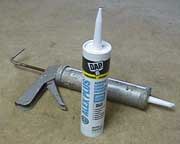
Vol. III, No. 11, November / December 2004
- The Impact of Density and the Definition & Ratio of Activity Centers on Children in Childcare Classrooms
- Early Childhood Facilities Design Institute
- De-Ice, Nicely
- Spending Time In Nature Helps Children with ADHD
- PCB Threat From Caulking
- Vicki Builds a Playground
- Child Care Business Institute
- Recent Projects
PCB Threat From Caulking
 Caulking
materials are widely used in the construction industry to provide a tight
seal for a building and to help cut down on energy costs.
Caulking
materials are widely used in the construction industry to provide a tight
seal for a building and to help cut down on energy costs.
A recent study published in the July 2004 issue of Environmental Health Perspectives shows that caulking used in buildings in the 1960's and 70's threatens public health. The warning was spurred by the discovery of high polychlorinated biphenyl (PCB) levels in Boston-area buildings. The US government banned the use of these chemicals in 1977 because of health and environmental concerns. PCB's are known persistent bioaccumulative toxins and probable human carcinogens. They are also likely endocrine disputers, or developmental toxins, which raise concerns over PCB contamination in older child care centers or public schools.
A variety of caulking materials have widely different chemical compositions. However, all caulking materials share the following common characteristics:
- They all use solvents to keep the material pliable until it is installed.
- Once applied, the solvents will evaporate and fumes will be given off as the material sets or cures.
Fumes from caulking can cause respiratory irritation or other allergic reactions. When using caulking in an early childhood environment, make sure the work area is well ventilated and provide additional ventilation during the curing period. The curing time can vary from days to weeks.
Study the label carefully of all calking materials and do the appropriate
research on all other building materials that go into your construction or
renovation project to make sure they don't pose an environmental hazard
for young children, who are much more sensitive to chemicals than adults.
Vol. III, No. 11, November / December 2004
- The Impact of Density and the Definition & Ratio of Activity Centers on Children in Childcare Classrooms
- Early Childhood Facilities Design Institute
- De-Ice, Nicely
- Spending Time In Nature Helps Children with ADHD
- PCB Threat From Caulking
- Vicki Builds a Playground
- Child Care Business Institute
- Recent Projects

